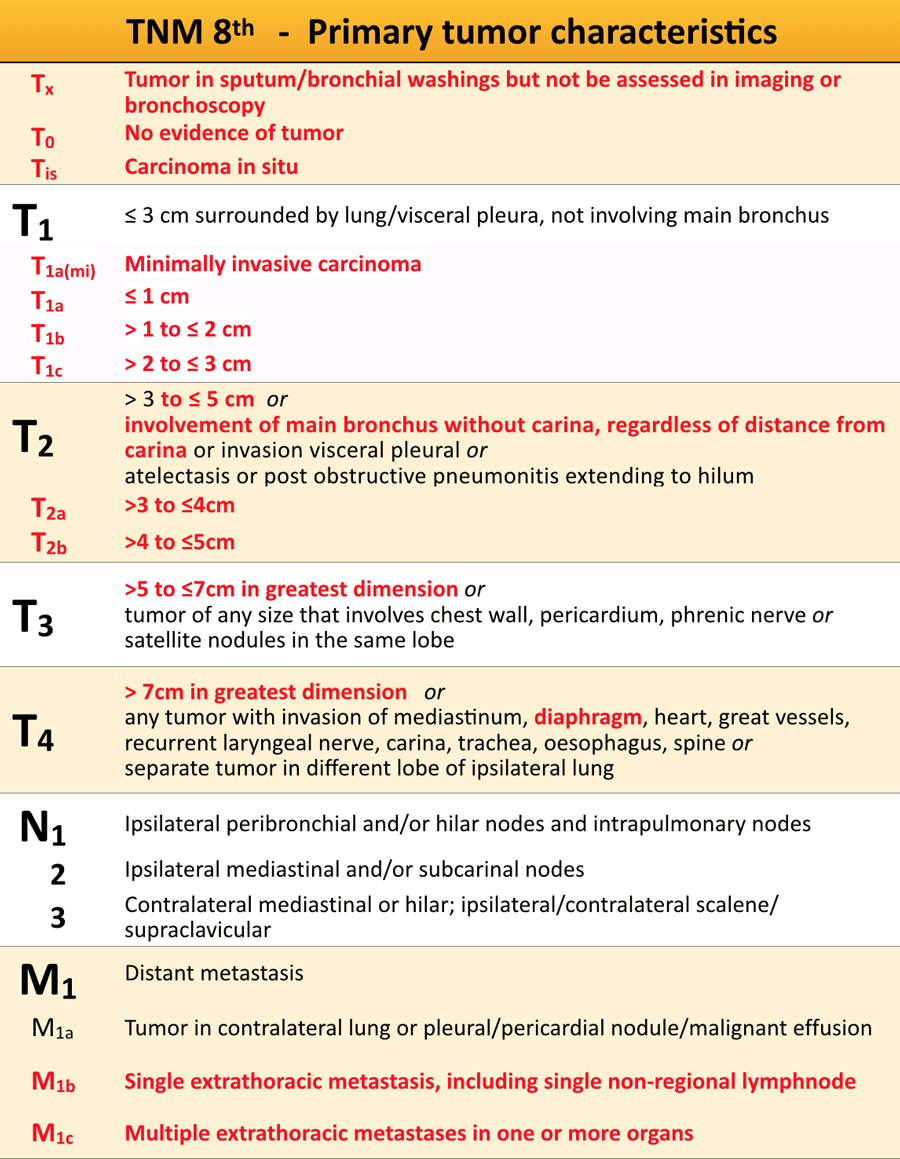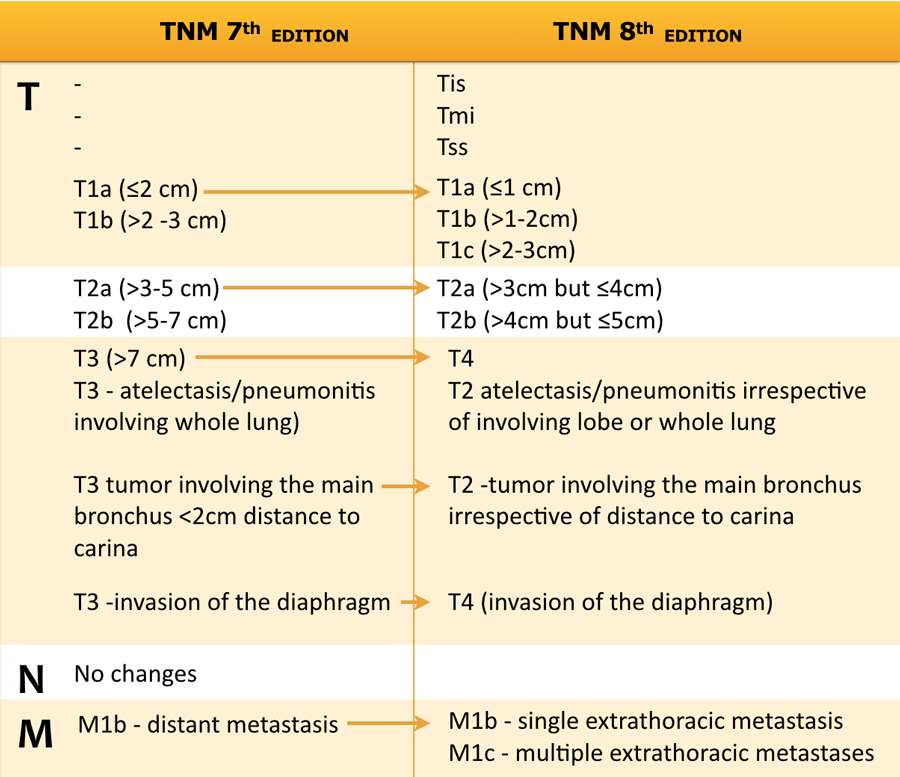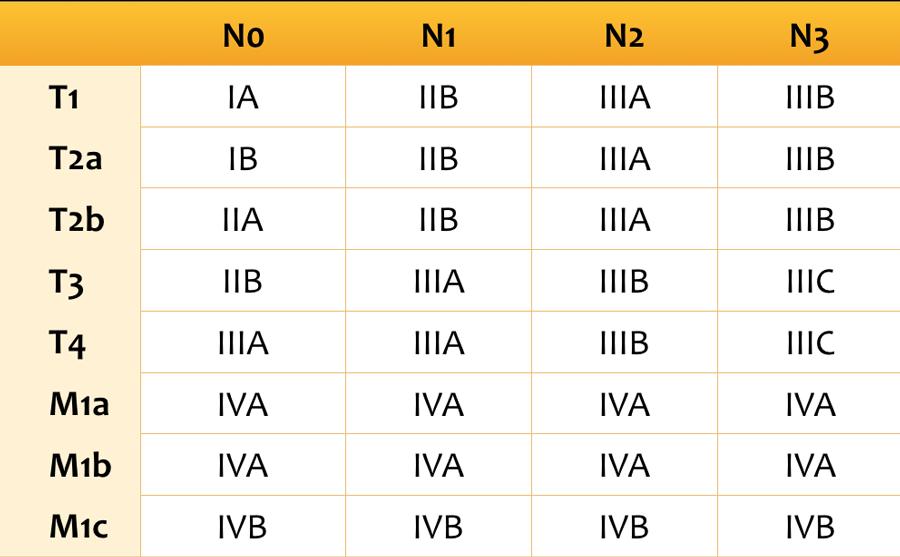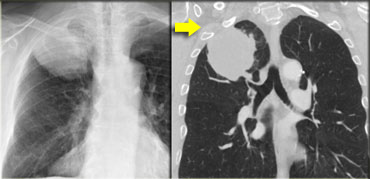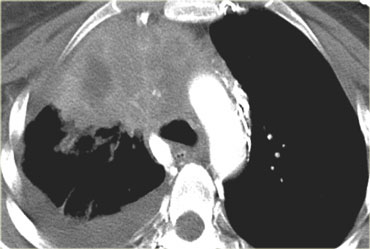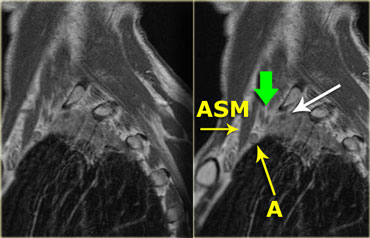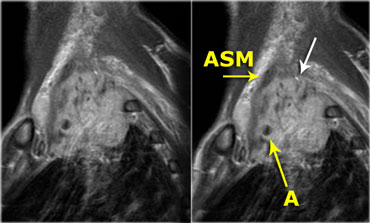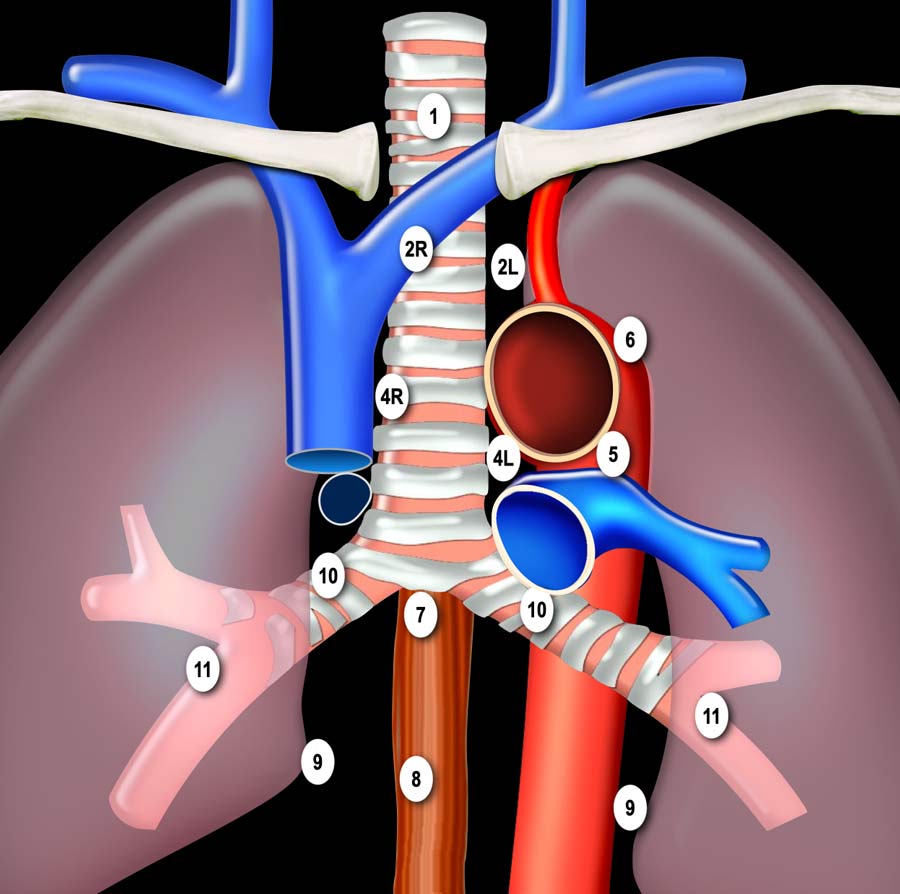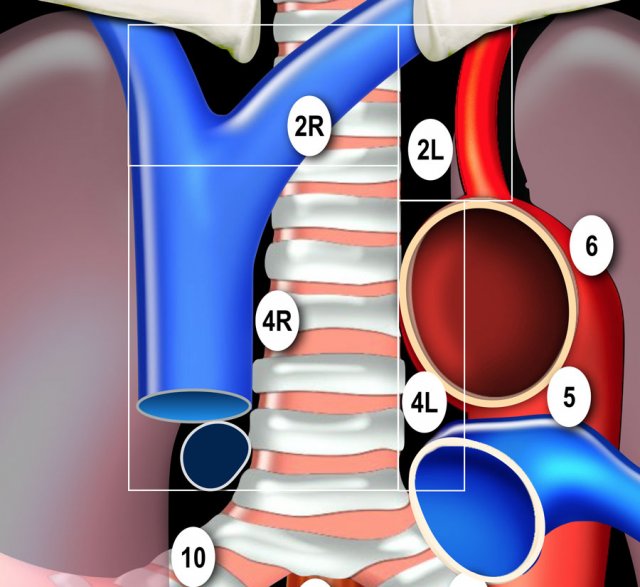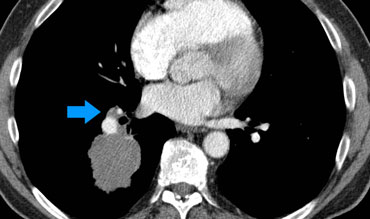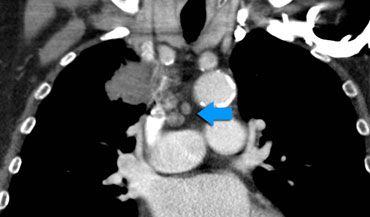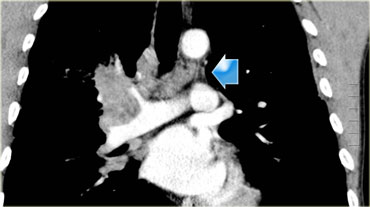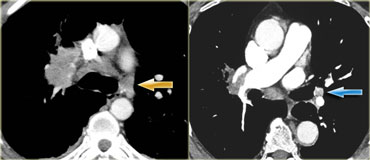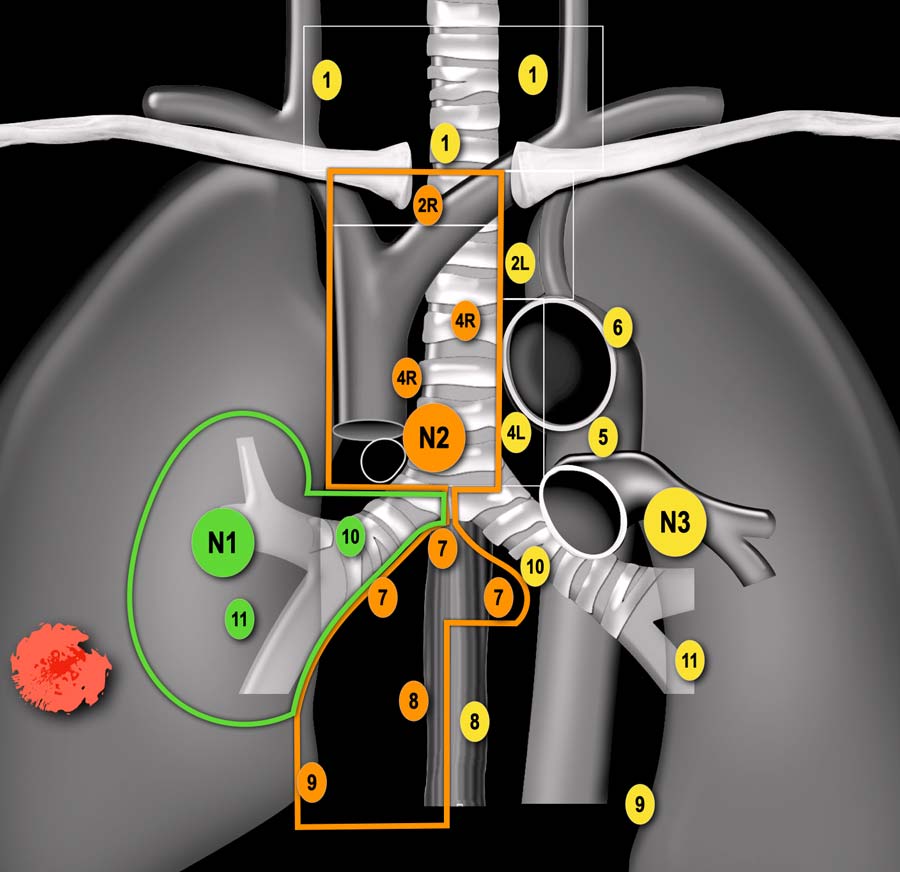TNM classification 8th edition
Onno Mets and Robin Smithuis
Department of Radiology of the Academical Medical Centre, Amsterdam and the Alrijne Hospital, Leiderdorp, the Netherlands
Publicationdate
This is a summary of the 8th Edition of TNM in Lung Cancer, which is the standard of non-small cell lung cancer staging since January 1st, 2017.
It is issued by the IASLC (International Association for the Study of Lung Cancer) and replaces the TNM 7th edition.
TNM-8
The 8th edition of the TNM classification for non-small lung cancer is shown in the table.
Conform previous editions there are three components that describe the anatomic extent of the tumor: T for the extent of the primary tumor, N for lymph node involvement, and M for metastatic disease.
T-classification is performed using CT, the N- and M-classification using CT and PET-CT.
It can be used in the pre-operative imaging and clinical classification iTNM/cTNM, but it is also applicable for definitive pathological staging pTNM, re-staging after therapy yTNM and staging of a recurrence rTNM.
Differences with the 7th edition are presented in red.
What is new in the TNM 8th edition
In the new TNM 8th edition the size went down for several T-categories, and some new pathology based categories were introduced.
Also, new M-categories were introduced regarding extrathoracic metastatic disease.
Size of a solid lesion is defined as maximum diameter in any of the three orthogonal planes in lung window.
In subsolid lesions T-classification is defined by the diameter of the solid component and not the diameter of the complete groundglass lesion.
Non-small lung cancer stages
Subsets of T, N and M categories are grouped into certain stages, because these patients share similar prognosis [1].
For example cT1N0 disease (stage IA) has a 5-year survival of 77-92%.
On the other end of the spectrum is any M1c disease (stage IVB) that has a 5-year survival of 0%.
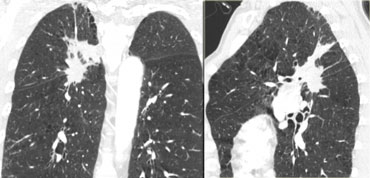 Lungcancer with evident transfissural growth on both the coronal and sagittal reconstructions; lobectomy is no longer possible.
Lungcancer with evident transfissural growth on both the coronal and sagittal reconstructions; lobectomy is no longer possible.
Lobectomy is generally not possible if there is:
- Transfissural growth.
- Pulmonary vascular invasion.
- Invasion of main bronchus.
- Involvement of upper and lower lobe bronchi.
These are specific items to report.
Thin-slice images and three-plane reconstructions are necessary to best demonstrate the relation with surrounding structures.
In case of indeterminate invasion, the multidisciplinary oncology board should decide whether the benefit of doubt is given, depending on the individual case and co-morbidity.
T-classification
T0
- There is no primary tumor on imaging
Tis
- Carcinoma in situ, irrespective of size.
This can only be diagnosed after resection of the tumor.
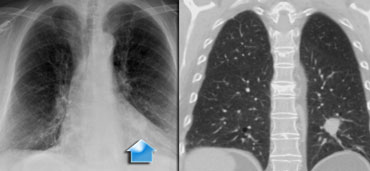 T1 tumor – A typical T1 tumor in the left lower lobe, completely surrounded by pulmonary parenchyma.
T1 tumor – A typical T1 tumor in the left lower lobe, completely surrounded by pulmonary parenchyma.
T1
Tumor size ≤3cm
- Tumor ≤1cm => T1a
- Tumor >1cm but ≤2cm =>T1b
- Tumor >2cm but ≤3cm => T1c
T1a(mi) is pathology proven 'minimally invasive', irrespective of size.
T1a(ss) is a superficial spreading tumor in the central airways, irrespective of location.
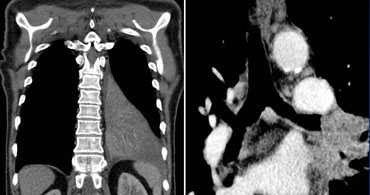 T2 tumor - A typical T2 tumor with atelectasis/pneumonitis of the left lower lobe up to the hilum, due to involvement of the left main bronchus.
T2 tumor - A typical T2 tumor with atelectasis/pneumonitis of the left lower lobe up to the hilum, due to involvement of the left main bronchus.
T2
- Tumor size >3cm to ≤5cm or
- Tumor of any size that
- invades the visceral pleura
- involves main bronchus, but not the carina
- shows an atelectasis or obstructive pneumonitis that extends to the hilum
T2a= >3 to 4cm
T2b= >4 to 5cm
T3
- Tumor size >5cm to 7cm or
- Pancoast that involves thoracic nerve roots T1 and T2 only.
- Tumor of any size that
- invades the chest wall
- invades the pericardium
- invades the phrenic nerve
- shows one or more satellite nodules in the same lung lobe
T4
- Tumor size >7cm or
- Pancoast tumor that involves C8 or higher nerve roots, brachial plexus, subclavian vessels or spine
- Tumor of any size that
- invades mediastinal fat or mediastinal structures
- invades the diaphragm
- involves the carina
- shows one or more satellite nodules in another lobe on the ipsilateral side
Pancoast tumor
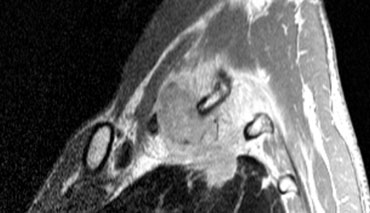
A Pancoast tumor is a tumor of the superior pulmonary sulcus characterized by pain due to invasion of the brachial plexus, Horner's syndrome and destruction of bone due to chest wall invasion.
MR is superior to CT for local staging.
An operable T3 Pancoast tumor on a sagittal contrast-enhanced T1-weighted image.
The tumor abuts the root T1 (white arrow), but other nerve roots are not involved (green arrow).
A = subclavian artery, ASM = anterior scalene muscle.
(Courtesy of Wouter van Es, MD. St. Antonius Hospital Nieuwegein, The Netherlands)
Here an inoperable T4 Pancoast tumor on a sagittal contrast-enhanced T1-weighted image.
Evident invasion of brachial plexus (white arrow) and encasement of the subclavian artery (A).
ASM = anterior scalene muscle.
N - Staging
Regional Lymph Node Classification System
Lymph node staging is done according to the American Thoracic Society mapping scheme.
Supraclavicular nodes
- 1. Low cervical, supraclavicular and sternal notch nodes
Superior mediastinal nodes
- 2. Upper Paratracheal: above the aortic arch, but below the clavicles.
- 3A. Pre-vascular: nodes not adjacent to the trachea like the nodes in station 2, but anterior to the vessels.
- 3P. Pre-vertebral: nodes not adjacent to the trachea, but behind the esophagus, which is prevertebral (3P).
Inferior Mediastinal nodes
- 4. Lower Paratracheal (including Azygos Nodes): below upper margin of aortic arch down to level of main bronchus.
Aortic nodes
- 5. Subaortic (A-P window): nodes lateral to ligamentum arteriosum. These nodes are not located between the aorta and the pulmonary trunk, but lateral to these vessels.
- 6. Para-aortic (ascending aorta or phrenic): nodes lying anterior and lateral to the ascending aorta and the aortic arch.
Subcarinal nodes
- 7. Subcarinal.
Inferior Mediastinal nodes
- 8. Paraesophageal (below carina).
- 9. Pulmonary Ligament: nodes lying within the pulmonary ligaments.
Pulmonary nodes
- 10-14. N1-nodes: these are located outside of the mediastinum.
The boundary between level 10 and level 4 is on the right the lower border of the azygos vein and on the left the upper border of the pulmonary artery (N1 vs. N2).
There is an important separation to be made between level 1 and level 2/3 nodes, because it is N3-stage versus N2.
The lower border of level 1 is the clavicles bilaterally and, in the midline, the upper border of the manubrium.
The boundary between level 4R and 4L is the left lateral border of the trachea, and not the anatomic midline.
Paracardial, internal mammarian, diaphragmatic, axillary and intercostal lymph nodes are not described in the IALSC lymph node map.
Occasionally these can be present.
It is proposed to regard these non-regional nodes as metastastic disease [2].
CT is unrealiable in staging lymph nodes in patients with NSCLC regardless of the threshold size that is chosen.
PET-CT is much more reliable in determining the N-status.
False-positives occur in patients with sarcoid, tuberculosis and other infections.
Because of the high negative predictive value, PET scanning should be performed in all patients considered for surgery.
N1 - Nodes
N1-nodes are ipsilateral nodes within the lung up to hilar nodes.
N1 alters the prognosis but not the management.
N2 - Nodes
N2-nodes represent ipsilateral mediastinal or subcarinal lymphadenopathy.
There is only a subset of patients with N2 disease that benefits from resection.
Those are the patients who -after a negative mediastinoscopy- are found to have microscopic metastatic disease at the time of thoracotomy.
These patients have a better prognosis than those with evident N2-disease.
N3 - Nodes
N3-nodes represent contralateral mediastinal or contralateral hilar lymphadenopathy or scalene or supraclavicular nodes.
These are irresectable.
The images show two patients with lung cancer on the right and contralateral nodes.
If these lymph nodes contain tumor cells, this means inoperable stage IIIB-disease.
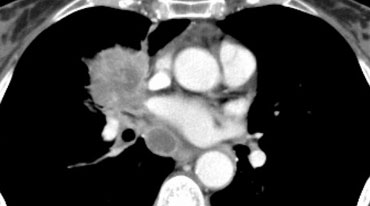
N3 - Nodes
N3-nodes represent contralateral mediastinal or contralateral hilar lymphadenopathy or any scalene or supraclavicular nodes.
These are irresectable.
For a tumor in the right lung the N-stages are:
N1
Ipsilateral peribronchial and/or hilar lymph nodes 10R-14R
N2
Ipsilateral mediastinal and/or subcarinal lymph nodes 2R, 3aR, 3p, 4R, 7, 8R, 9R
N3
Contralateral mediastinal and/or hilar, as well as any supraclavicular lymph nodes 1, 2L, 3aL, 4L, 5, 6, 8L, 9L, 10L-14L
For a tumor in the left lung the N-stages are:
N1
Ipsilateral peribronchial and/or hilar lymph nodes 10L-14L
N2
Ipsilateral mediastinal and/or subcarinal lymph nodes 2L, 3aL, 4L, 5, 6, 7, 8L, 9L
N3
Contralateral mediastinal and/or hilar, as well as any supraclavicular lymph nodes 1, 2R, 3aR, 3pR, 4R, 8R, 9R, 10-14R
M-Staging
Almost every organ may be involved in metastatic disease.
Common are adrenal, nodal, brain, bone and liver involvement.
M-staging in the current edition is based on the presence of metastases, their location and multiplicity.
A distinction is made between regional metastatic disease (M1a) and solitary (M1b) or multiple (M1c) distant metastatic disease:
- M0: No distant metastases
- M1: Distant metastases
- M1a: Regional metastatic disease defined as malignant pleural or pericardial effusion/nodules, as well as contralateral or bilateral pulmonary nodules.
- M1b: solitary extrathoracic metastasis
- M1c: Multiple extrathoracic metastases, either in a single organ or in multiple organs
